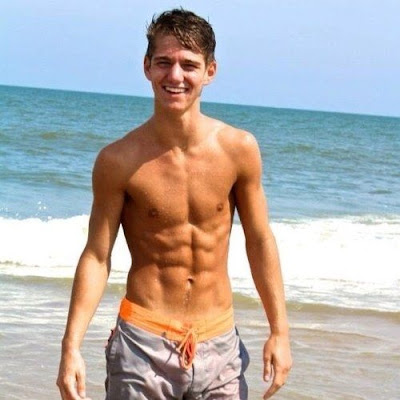The anthology American Horror Story, which goes through a single plotline per season, has a good but not great record of LGBT representation: the gay male characters are usually evil, or die immediately, or fall in love with women. But at least there are always musclemen taking their clothes off.
The spin-off American Horror Stories is worse. In Season 2 so far, there have been no gay male characters at all, just some lesbian and bisexual women. The straight male characers are always evil, trying to oppress, victimize, or literally objectify the women. And beefcake is as rare as nice guys.
Spoiler alert: I'm giving away the surprise ending of all of these stories.
Episode 1: "Dollhouse" In the 1950s, a crazy old guy notices that his son likes dolls, so he decides to turn some women into living dolls. He's also looking for a substitute for his dead wife. In an Easter egg, it's hinted that the boy will grow up to become a member of the witches' council in American Horror Story: Coven.. Presumably he's gay, but no sexual identity is specified, here or in Coven.
Episode 2: "Aura" When she uses a new security app, a woman sees a crazy old guy banging at her door. Her husband (Max Greenfield, top photo) thinks that she's crazy. Turns out that it's a harmless (albeit creepy) ghost. But hubbie is not so harmless.
Max Greenfield played a swishy gay villain on American Horror Story: Hotel. But there are no gay characters here. And no beefcake.
Episode 3: "Drive." A woman insists on going out to clubs and picking up strange men (and women), even though there's a serial killer stalking partiers. Turns out that she is the serial killer, with her husband Chaz (Anthony de la Torre) as an accomplice. This one has a muscle guy in his underwear (Nico Greetham) tied to a chair before he's butchered.
Why is she a serial killer? She's trying to get even with the dudebros who ridiculed her in high school, and their ilk today.
Episode 4: "Milkmaids." Two women in a smallpox-ridden village put their faith in science and develop a cure (over 100 years before Edward Jenner invented the smallpox vaccine). Meanwhile the snarling, superstitious men of the village, recently widowed Thomas (Cody Fern) and the Pastor (Seth Gabel), fulminate about witchcraft and plot homicide. The women begin a romantic relationship, but the men are both straight and hetero-horny. Even Thomas, though Cody Fern is gay in real life.
I had to just listen to this while pretending to be immersed in something on my cell phone, since the original cure involved...well, never mind.
Episode 5: "Bloody Mary." Four girls summon the urban-legend spirit, who orders them to perform horrifying tasks. No boys around except for a predatory guidance counselor and the crush of one of the girls (JJ Batteast), who keeps smooching on his girlfriend in front of her. Rude!
The transwoman Dominique Jackson stars as Bloody Mary, who started off as a cisgender woman with husband and son. Nothing LGBTQ here.
Episode 6: "Facelift." An elderly woman just wanted a facelift, but instead she runs afoul of a cult run by an evil (female) plastic surgeon. Next door neighbor Bernie (Todd Waring) seems to be interested in her, but he falls for a prettier girl instead, and in the end tries to kill her. Nothing gay here, and Bernie doesn't take off his clothes.
Episode 7: "Game Over." Dr. Ben Harmon (Dylan McDermott), who ran afoul of some gay ghosts in American Horror Story: Murder House, here is going on a tour of famous haunted houses (along with his wife, naturally). He meets various ghosts from past seasons, including the lesbian-lover pair from American Horror Stories, Season 1. But no gay men.















